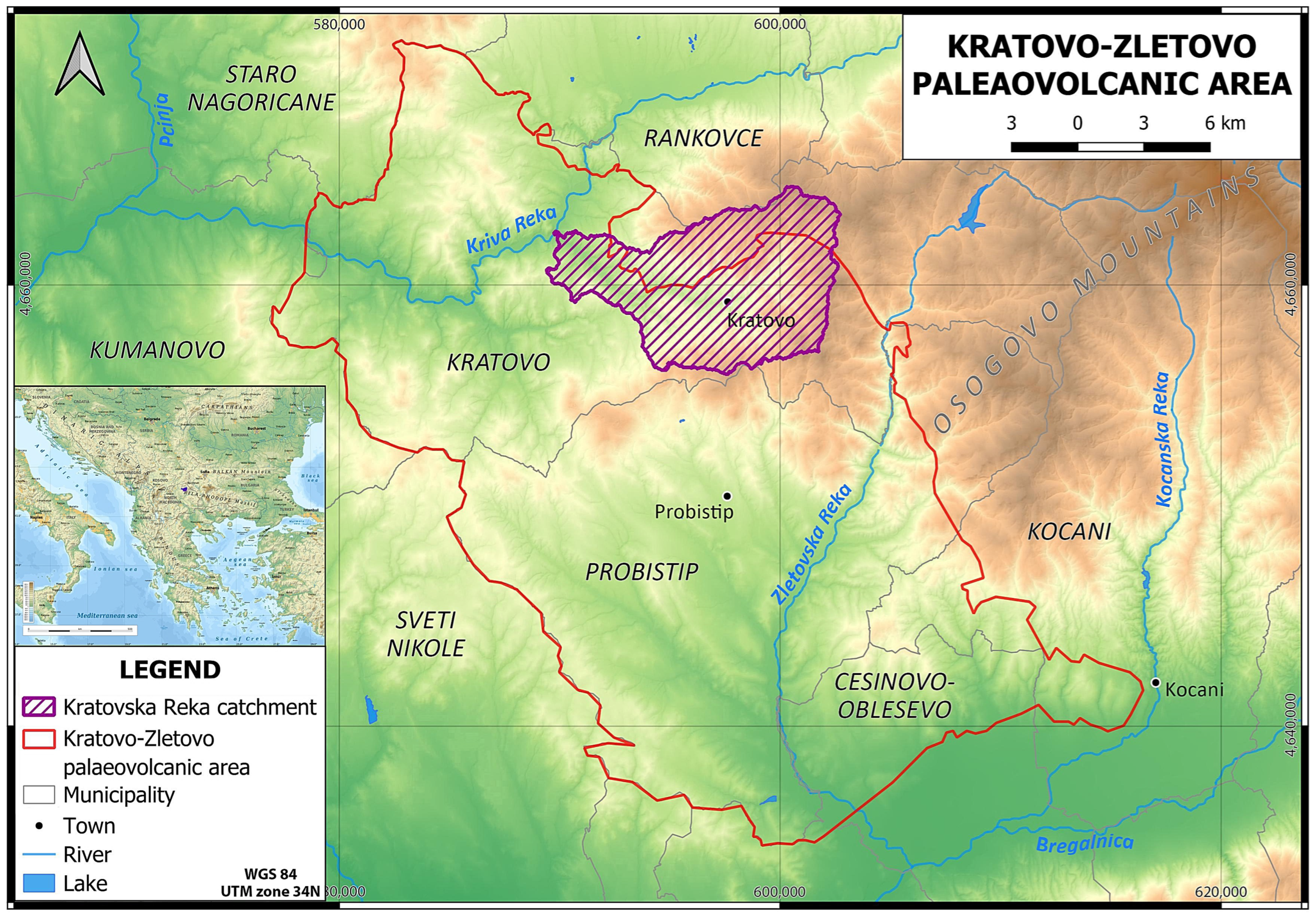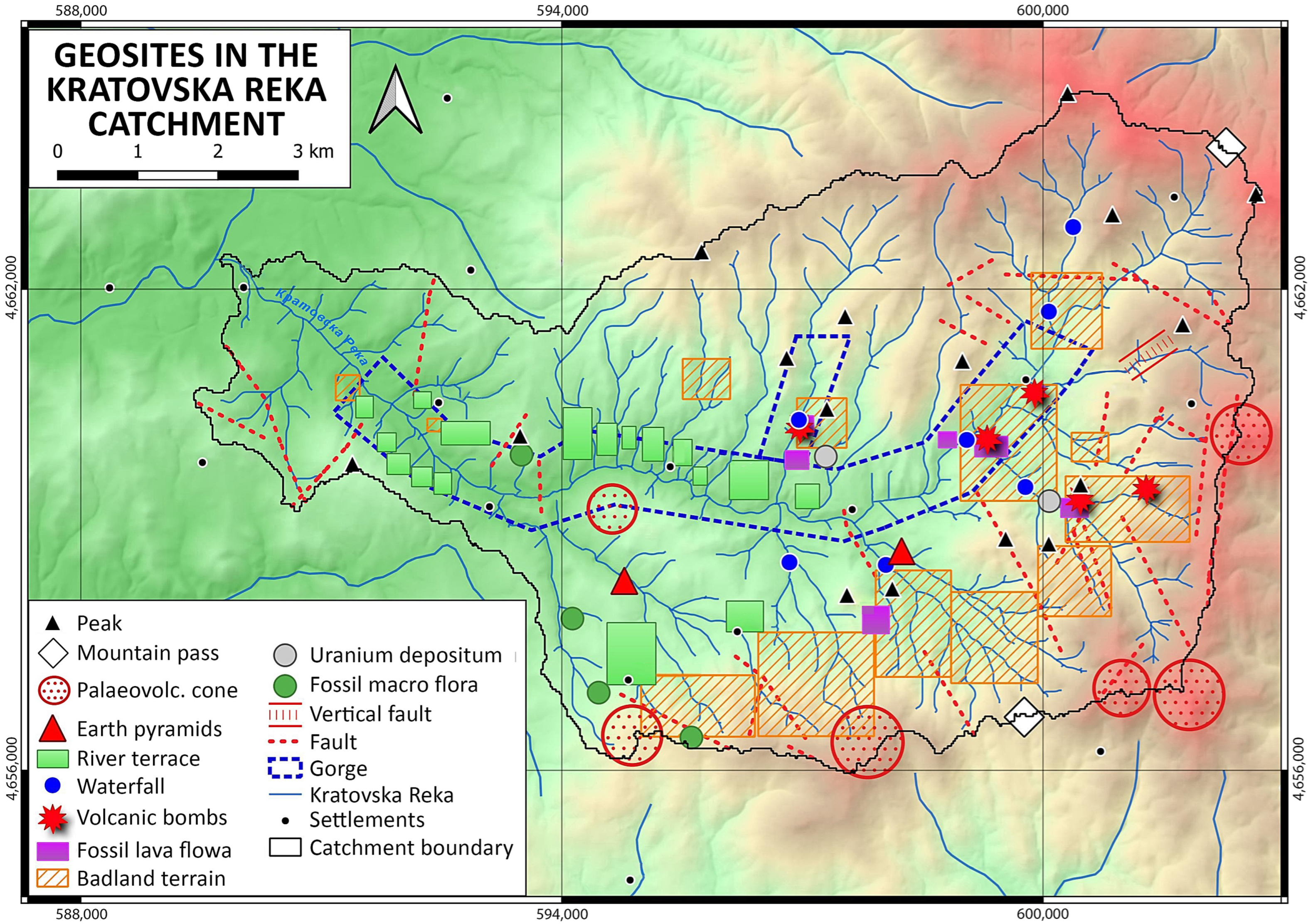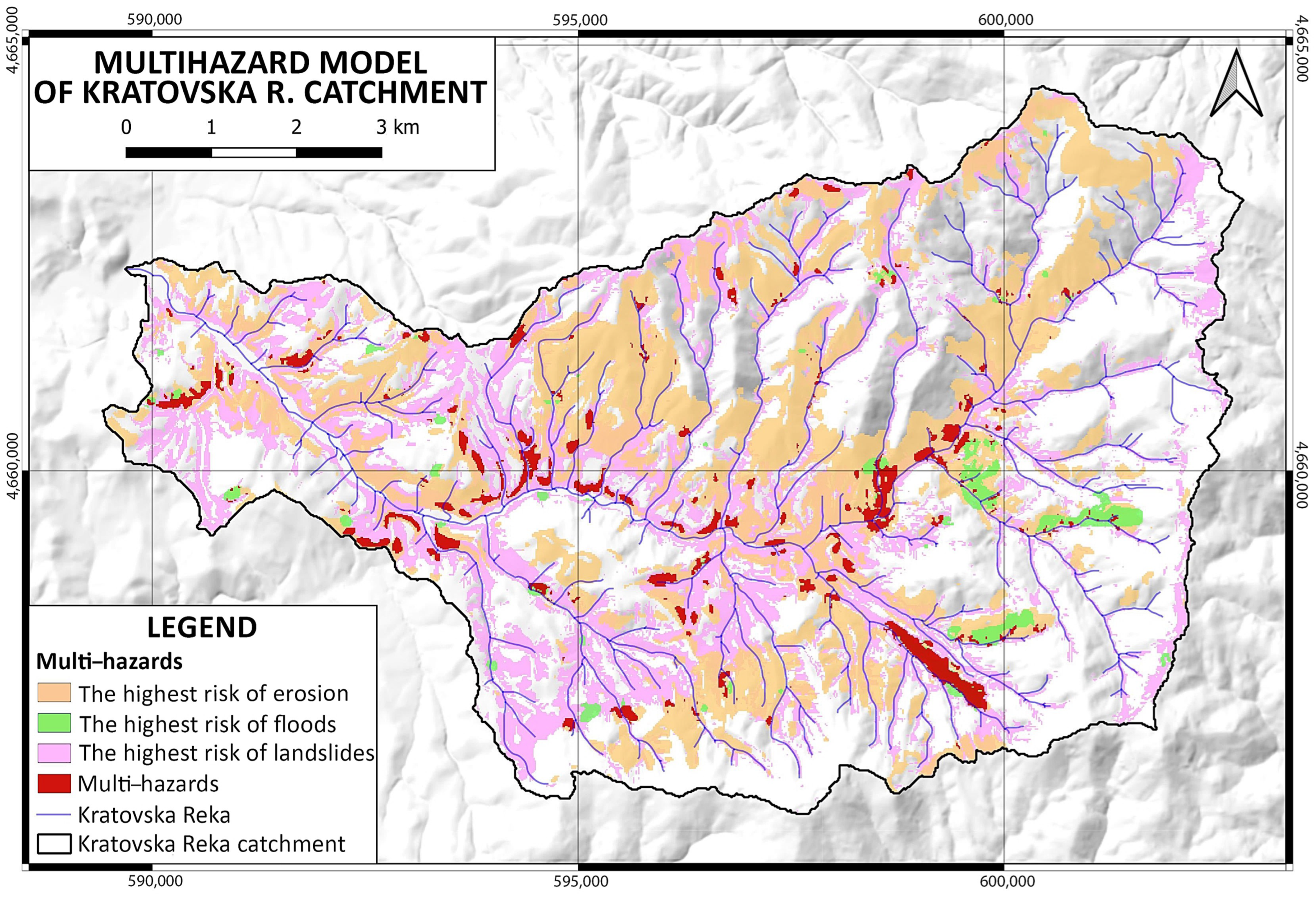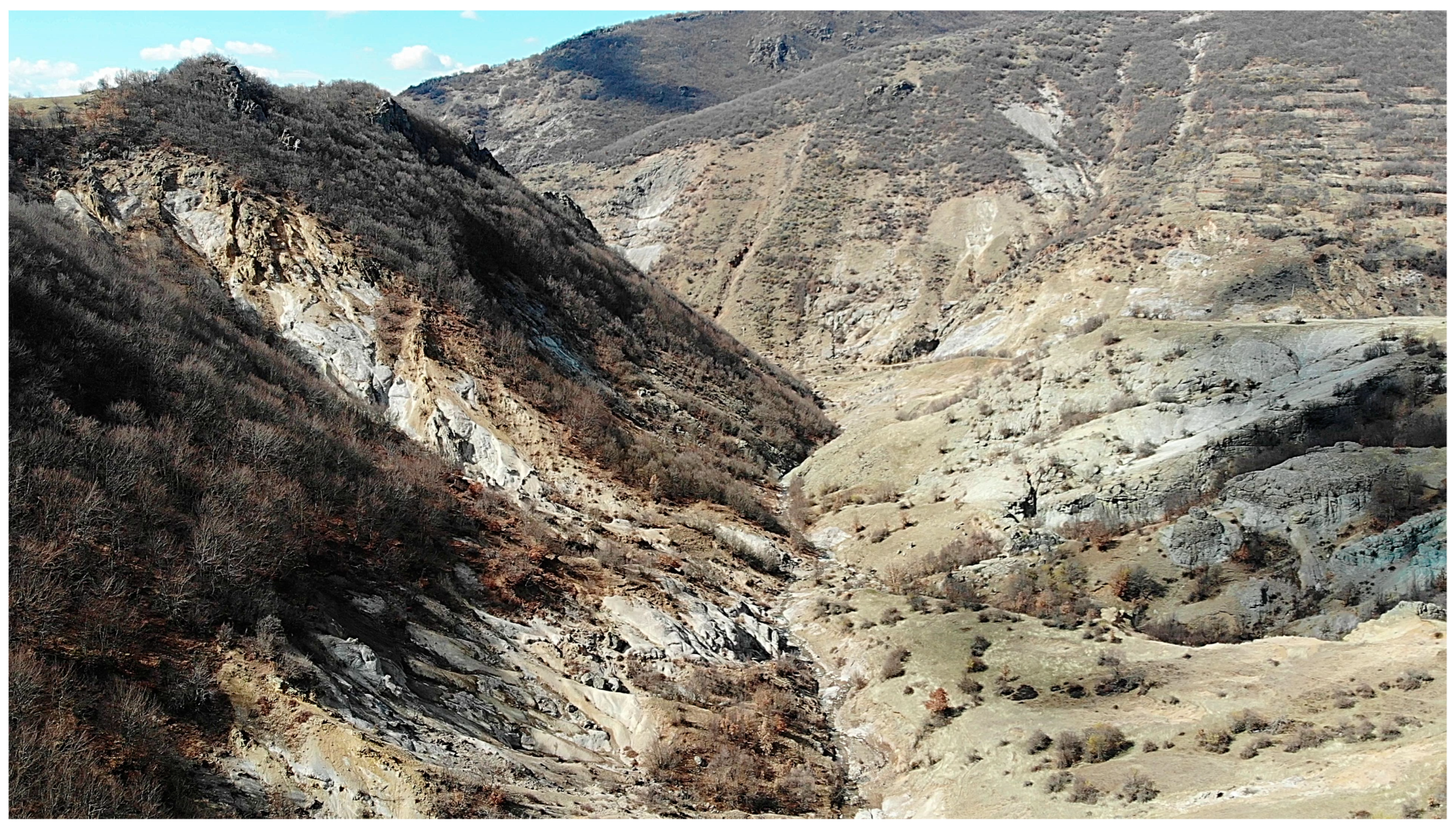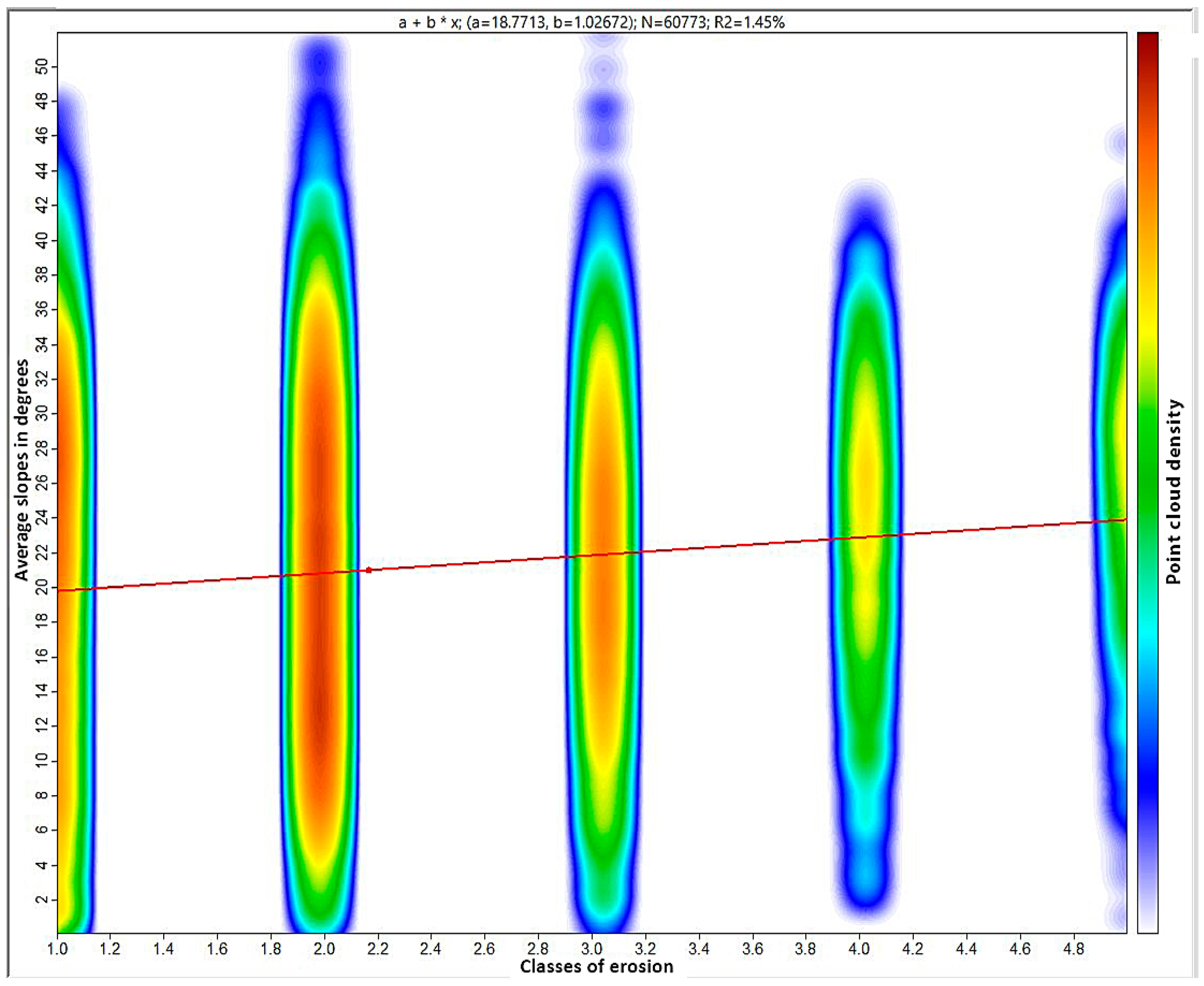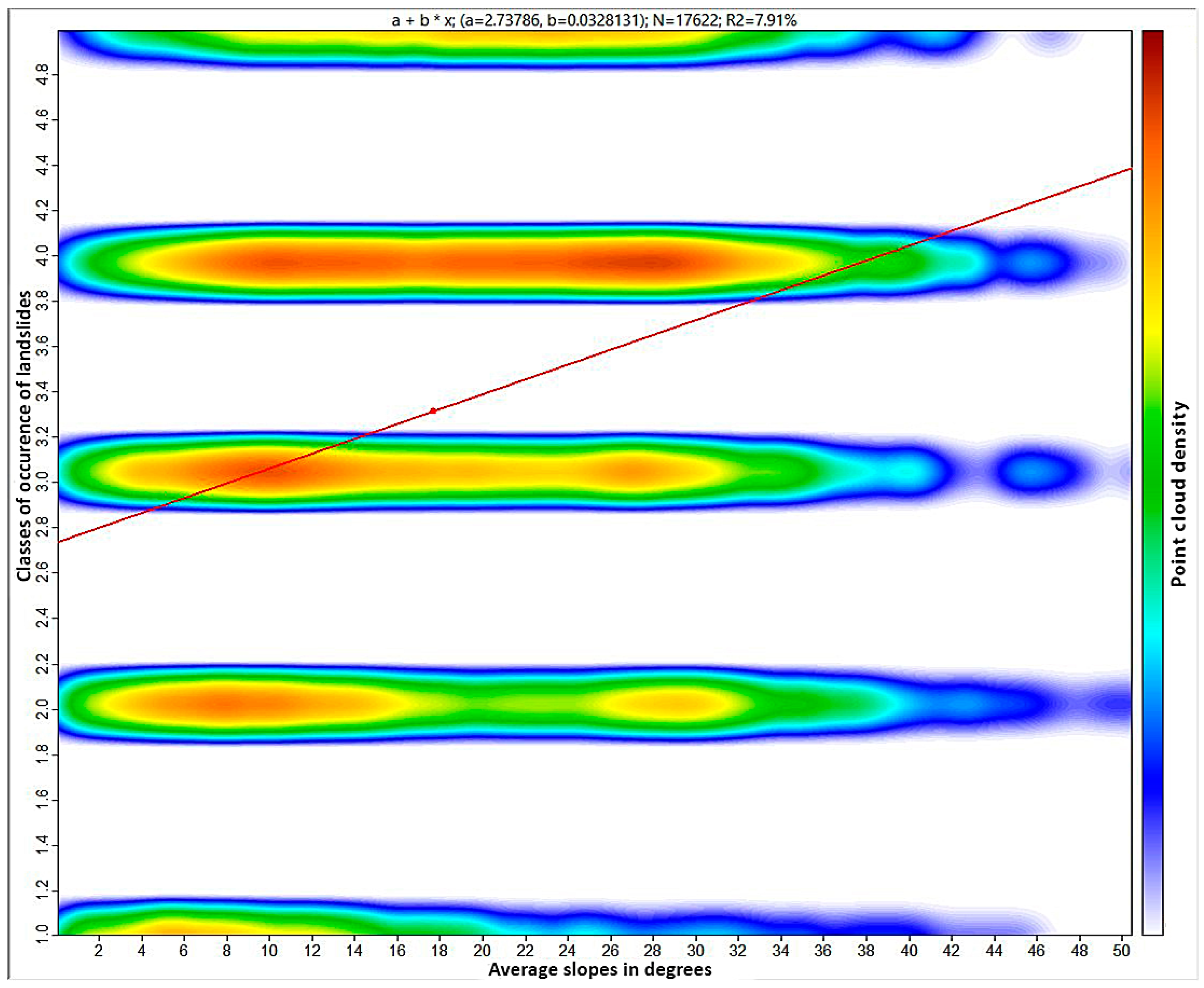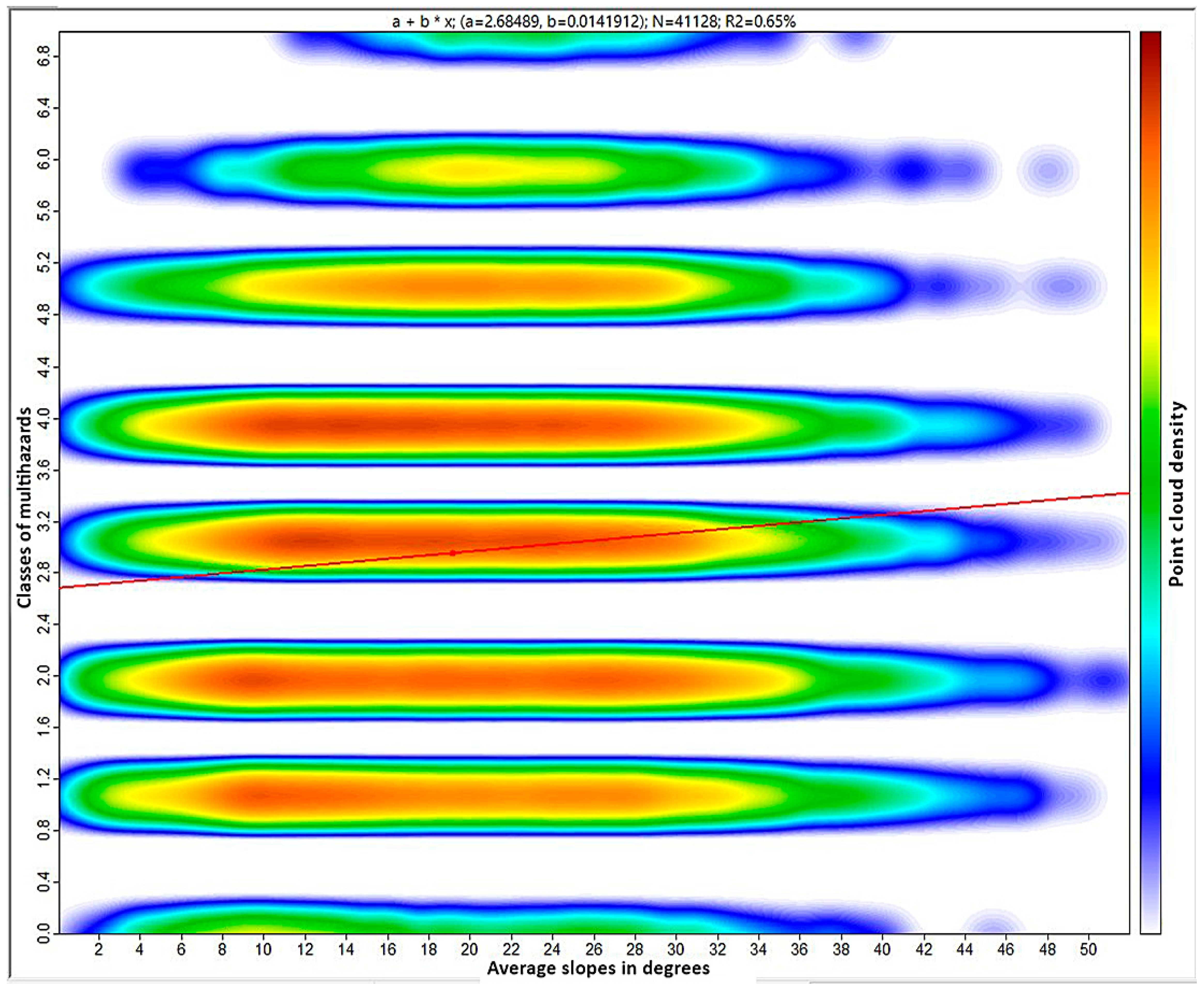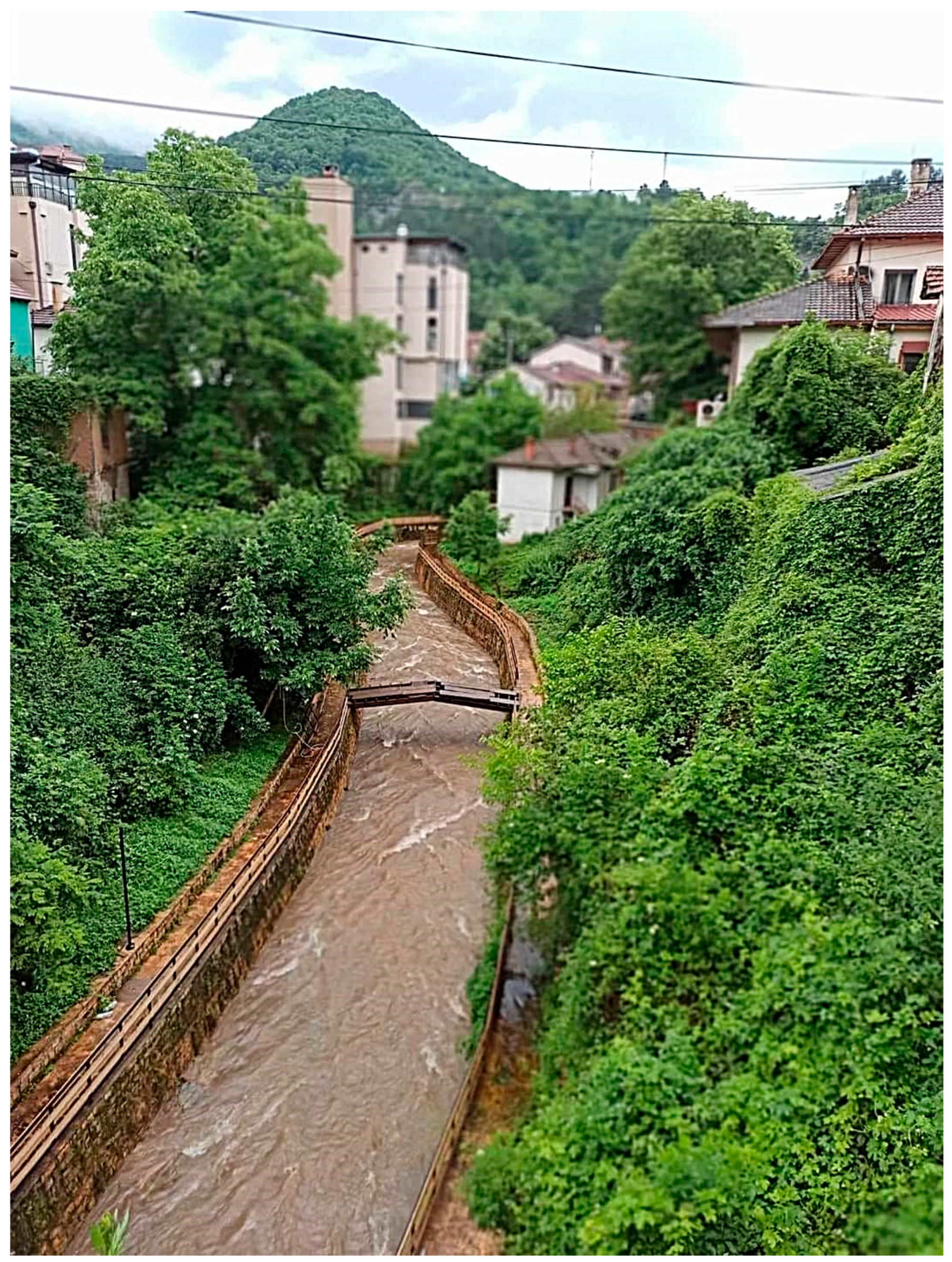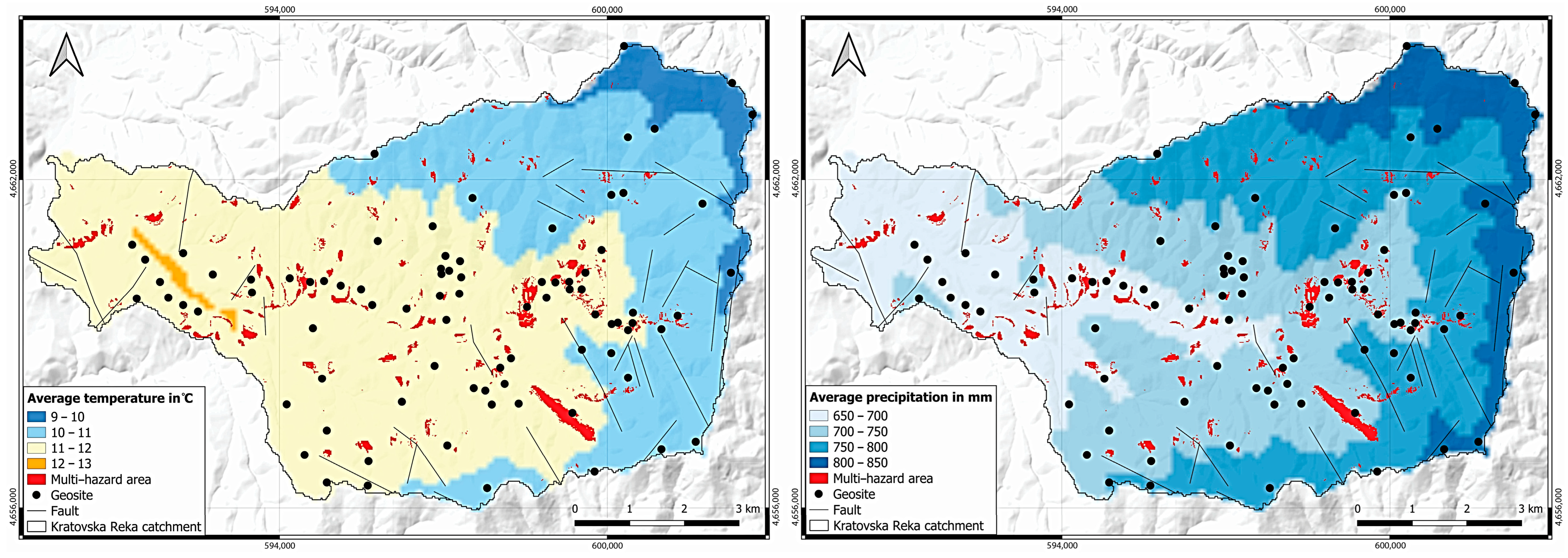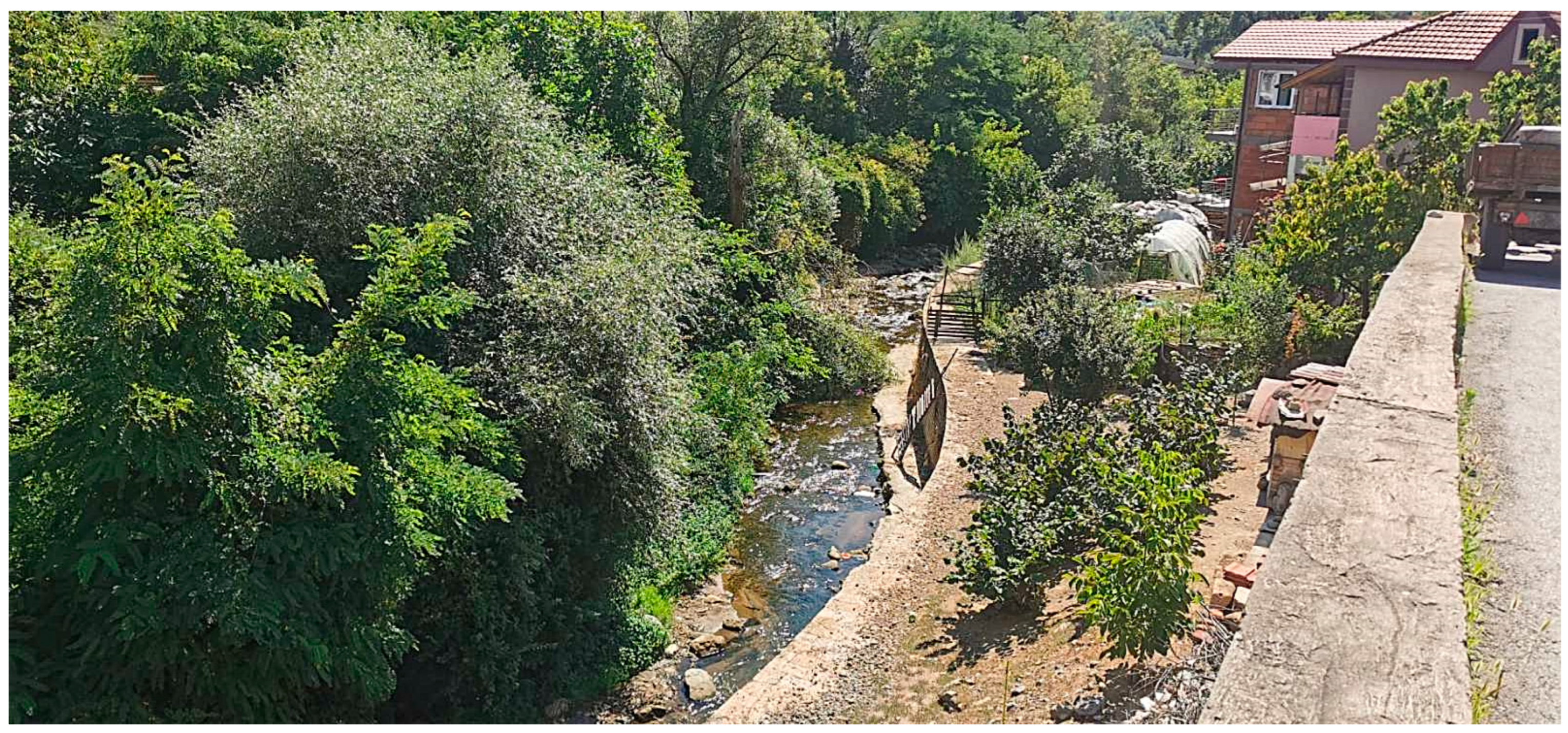3. Results and Discussion
A previous assessment reveals that the Kratovska Reka catchment boasts numerous, highly significant, and unique geosites. In fact, few watersheds can claim such remarkable geodiversity within a relatively small area. The primary reason for this lies in the extraordinarily turbulent geotectonic activity and dynamics of this part of the Balkan Peninsula in SE Europe, situated in the collision zone of the African and European (Eurasian) continental plates and their sub-segments. However, regardless of these highly valuable elements of geodiversity, there has been insufficient attention to the protection and promotion of these sites in North Macedonia during the previous period.
From scientific, educational, and tourist perspectives, these geosites hold particular significance. Despite the rich geodiversity, not a single geosite within the catchment area is currently protected. Consequently, the geodiversity of this area warrants much greater attention and protection, especially as a component of geotourism (
Figure 2).
The initial results indicate the highest susceptibility to geohazards within the catchment, highlighting areas with a representation of two and three geohazards. According to calculations (
Table 2), 15.04% of the basin is classified as areas with a high susceptibility to excessive erosion and landslides. Particularly notable is the risk in the valley of the Kratovska Reka and its tributaries. Risks of excessive erosion and flash floods have been identified in the source parts of the tributaries of Kratovska Reka, especially in the valleys of Latišnica and Babakarina Reka (5.71%). High susceptibility to landslides and flash floods is evident in the sub-basins of Šlegovski and Manev Dol (left tributaries of the Kratovska Reka) and the downstream town of Kratovo (5.13%).
The model (
Figure 3) was created to illustrate areas with the highest risk susceptibility to specified geohazards (highest risks of excessive erosion, landslides, and flash floods) and areas affected by multi-hazards (overlapping of three geohazards). Thus, 30.07% of the basin is designated as areas with the highest risk of excessive erosion, 34.35% with the highest risk of landslides, and 5.76% with the highest risk of flash floods.
According to the generated model, areas with multi-hazards (excessive erosion, susceptibility to landslides, and flash floods) were identified. Calculations indicate that 4% of the basin falls into this class with a high risk of potential occurrence of all three observed geohazards, primarily concentrated in the sub-basins of Babakarina Reka, Latišnica, and Bela Reka, downstream of the village Gorno Kratovo, and along the Kratovska Reka valley in the downstream town of Kratovo. This is because these terrains are distinctly steep and exposed. Particularly, the sub-basins of Babakarina Reka and Latišnica, along with the paleovolcanic area in the village Gorno Kratovo, lack adequate vegetation cover, making them significantly vulnerable to excessive erosion processes and other types of geohazards, such as flash floods and landslides. In total, 56.07% of the basin (equivalent to 38.45 km2) is susceptible to the risk of geohazards.
In the model depicted in
Figure 3, interactions among different geohazards (such as excessive erosion, landslides, and flash floods) are considered by identifying areas where these hazards overlap or coincide. This is undertaken to evaluate the cumulative risk posed by multiple hazards in specific areas. Specifically, the model indicates that approximately 4% of the basin is classified as experiencing multi-hazards, meaning these areas are at high risk for all three observed geohazards simultaneously [
2]. To account for the impacts caused by statistical calculations, the model likely utilizes data on the susceptibility and occurrence of each geohazard individually, and then integrates these datasets to identify areas where multiple hazards coincide. Statistical calculations are employed to quantify the level of risk linked with each hazard and to evaluate the probability of multi-hazard occurrences in various sections of the basin. In summary, the model considers interactions among various geohazards by identifying areas where multiple hazards overlap, and statistical calculations are employed to assess the combined risk and potential impacts of these hazards on the studied area.
For the purposes of research related to geodiversity, it is necessary to understand the lithological composition of the terrain, as it is considered an important factor influencing the intensity of erosion processes and the natural conditions on the given terrain. When analyzing the lithological composition, it is essential to consider the physical and mechanical properties of the rocks, especially in terms of their resistance to physical and chemical decomposition, as well as other erosive processes. In accordance with this goal, a correlation was made between the representation of the classes of geohazards (excessive erosion, landslides, flash floods, and multi-hazards, respectively) and the types of rocks present in the geological structure of the Kratovska Reka catchment, including schists, solid volcanics and tuffs, ignimbrites, and clastic sediments. Solid volcanics, mainly represented by andesites, are characterized by relatively high erosion resistance. Therefore, there is a low to moderate risk of geohazards (excessive erosion, landslides, and flash floods) occurring here. In terms of geodiversity, distinct river terraces, badlands, and the striking volcanic neck Zdravči Kamen geosite are located in this area.
Shales are characterized by high resistance to erosion processes, but due to the bareness of the terrain and the steep valley sides of the Kratovska Reka, there is a high risk of geohazards, especially excessive erosion and the occurrence of landslides. Geodiversity in this part of the catchment is represented by a weak presence of badland terrains, waterfalls, and fossil macro flora.
Volcanic rocks such as tuffs and dacite ignimbrites are the most striking features of this area because they are part of the Kratovo–Zletovo paleovolcanic area. They occupy the largest part of the catchment, and are characterized by very weak resistance to erosion. In order to make a correlation between the surfaces susceptible to geohazards on different types of rocks, clastic sediments are also included in this group because they are mutually characterized by very weak erosion resistance. Indeed, these areas boast the most diverse geological and geomorphological formations, including volcanic mounds, earth pyramids, badland terrains, waterfalls, volcanic bombs, passes, fossil macro flora, and deposits of lead–zinc ore, uranium, etc. However, the weak resistance to erosive processes led to a pronounced risk of geohazards and multi-hazards, respectively (
Table 3;
Figure 4).
The basic features of relief are hypsometry, slopes, exposure, and terrain ruggedness index (TRI). It is important to emphasize that the relief has a significant influence on the occurrence of diverse geodiversity elements, and at the same time on the occurrence of certain types of geohazards. Because of this, it is considered that the relief is a dynamic phenomenon subject to constant morphological changes, and the result of the changes depends on the intensity of the process and their duration, respectively. The relief in the Kratovska Reka catchment is very diverse. It is mainly represented by structural (mountain peaks and mountain passes), paleovolcanic (volcanic mounds, volcanic cones, volcanic necks, volcanic centers, volcanic bombs, and fossil lava flows), denudation (earth pyramids and badland terrains), fluvial (waterfalls, gorges, and river terraces) and fossil abrasive forms (a remnant of a lake terrace). Hence, it is evident that the terrain has given rise to diverse geological and geomorphological features in the Kratovska Reka catchment. Conversely, it significantly influences the occurrence of geohazards, including excessive erosion, landslides, and flash floods. The paleovolcanic relief is highly prone to erosive processes and, when coupled with other factors such as steep slopes and exposed terrain, contributes to a substantial risk of potential geohazards (
Figure 5). Furthermore, the manifestation of geohazards in the catchment leads to alterations in the terrain, affecting geosites. For instance, erosion processes bring about modifications to volcanic cones and mounds, badlands, and earth pyramids.
Morphometric features are closely linked with the interplay of geodiversity and geohazards within the Kratovska Reka catchment. To illustrate this connection, an analysis of the relationship between geohazards and the morphometric features of the terrain was conducted.
Table 4 offers a summary of the average values of morphometric characteristics for each geohazard class.
With an increase in altitude, there is a decrease in air temperature, creating conditions for thermal and ice decomposition of rocks. Additionally, there is an increase in the amount of precipitation, contributing to excessive water erosion. The increase in altitude enhances the physical breakdown of rocks as a dominant geomorphological process, intensifying its effects. However, at higher altitudes, there is an increase in forestation, and the topographic surface is mostly protected by snow cover throughout most of the year. Simultaneously, the impact of destructive human activities decreases proportionally with the elevation of the relief. Consequently, there is a higher risk of excessive erosion, landslides, and flash floods at lower altitudes in the catchment area (nearby roads and settlements) than at higher altitudes (
Figure 6). As mentioned earlier, geological composition significantly influences these patterns. The graph illustrates that as the classes of flash floods (the FFPI coefficient) increase, the altitude decreases. Conversely, at higher altitudes, there is a higher potential for flash floods, indicated by a higher FFPI coefficient.
Slopes are fundamental factors in the interplay between geodiversity elements and geohazards. In the catchment of the Kratovska Reka, areas with steep slopes contribute to the formation of waterfalls, badlands, earth pyramids, and other features. Additionally, slopes exert a significant influence on the intensity of erosion processes, thereby affecting the occurrence of flash floods and landslides. Specifically, areas with steep and very steep slopes (<30˚) are identified as multi-hazard risk areas.
From the next graph (
Figure 7), it can be observed that an increase in the erosion class corresponds to an increase in the average slope, indicating that higher slopes are associated with a greater potential for excessive erosion and degradation of geodiversity elements.
From the graph (
Figure 8), it is evident that with the increase in the class of landslides, the average slope also increases; conversely, on steeper slopes, the potential for landslides is greater.
From the next graph (
Figure 9), it is evident that as the FFPI coefficient increases, the average slope also increases; conversely, on steeper slopes, the potential for flash floods is higher.
The final graph (
Figure 10) illustrates that as the multi-hazard susceptibility increases, the average slope also rises. Conversely, larger slopes correspond to a higher incidence of multi-hazards.
Aspect exerts a profound effect on the erosional processes in the catchment. Southern aspects receive the most heat, especially in areas dominated by western and southwestern aspects. During the afternoon, when air temperatures rise, rocks on these aspects heat up, causing moisture in the land to evaporate. Solar heating energizes the topographic surface and the air, contributing to both the physical breakdown of rocks and increased erosion. Conversely, large slopes on northern aspects receive sunlight only briefly twice a day, leading to higher humidity and favorable conditions for forest cover. This, in turn, results in a lower denudation intensity compared to southern aspects.
The terrain ruggedness index (TRI) has a minimal influence on erosion intensity, while the terrain altitude, as explained earlier, plays a significant role. Erosion is dominant on positive relief forms, with a breakdown of up to 20 m per 1 km2. This factor has a mutually weak impact on geodiversity and the occurrence of geohazards.
The nature of soils is another crucial factor affecting erosion intensity, especially in combination with steep slopes, terrain bareness, and strong water currents. In the higher parts of the catchment, soil types such as regosols, eroded brown forest soil, resin soils, and lithosols occur on exposed surfaces experiencing intense excessive erosion and degradation. The spatial distribution of these soils contributes to the appearance of earth pyramids, highlighting the relationship between geodiversity elements and geohazards.
To enhance our understanding and establish correlations between geodiversity and geohazards, we conducted a correlation analysis between soil types and the areas at highest risk of excessive erosion, landslides, flash floods, and multi-hazard zones (
Table 5). In this process, we utilized the National Soil Map of Macedonia in raster format [
22].
The findings reveal that areas most prone to the identified geohazards predominantly feature forest soil, regosol, and leptosol soils (identified as a combined area). Forest soil, primarily eroded due to deforestation in the 21st century, exhibits a sandy loam texture with notable clay and CaCO3 contents. Regosols, characterized by a shallow depth and higher clay and CaCO3 contents, further contribute to the susceptibility to erosion. Similarly, leptosols with poorly defined horizons exacerbate the risk of erosion processes. In fact, the forest soil passes into a regosol and then into a leptosol because of the intense erosive processes. This combination underscores the causal relationship between geodiversity and geohazards, as it significantly influences the intensity of these hazards. In general, soil types such as forest soil, regosol, and leptosol exert the most significant impacts on geohazards, particularly in terms of excessive erosion, landslides, and flash floods. These soil types affect larger areas and pose greater risks compared to others, such as ranker, which have minimal effects on geohazards.
Regosols, forest soils, and leptosols, prevalent in the highest-risk zones of geohazards and multi-hazard areas, interact with slope gradients to exacerbate geohazards. Regosols, due to their loose texture, exacerbate erosion and landslides on steep slopes. Forest soils, abundant in vegetation, typically stabilize slopes by binding soil particles, but deforestation weakens this protective function. Leptosols, with their shallow depth and susceptibility to erosion, pose risks on steep slopes by facilitating rapid runoff. The combination of these soil types with varying slope gradients significantly increases vulnerability to geohazards.
Climate, one of the main factors in shaping geomorphological forms, also influences the intensity and frequency of geohazards. Air temperature plays a key role in overall denudation process, with freezing and thawing cycles occurring in the catchment. Fluctuating air temperatures around the freezing point lead to chemical decomposition of rocks. Additionally, higher air temperatures, particularly downstream of the town of Kratovo, increase the chemical decomposition of rocks. Temperature variations affect the types of rocks present in the catchment, contributing to the modification and shaping of various geological formations. Therefore, air temperature plays a significant role in the intensity of geohazards’ occurrence within the study area.
Moreover, the climate has a significant impact on increasing the intensity of excessive erosion. Specifically, higher temperatures, particularly in the extreme western part of the catchment, lead to more frequent freeze–thaw cycles of rocks. This ever-occurring process weakens rocks and soils, making them more susceptible to excessive erosion. Additionally, elevated temperatures increase evaporation, reducing the soil moisture content and making the soil more susceptible to erosion processes. Freeze–thaw cycles, occurring when water infiltrates cracks in rock or soil and then freezes and expands, can weaken slope stability. Rapid temperature changes can intensify the frequency of these cycles, rendering slopes more prone to landslides (
Figure 11). Moreover, temperature influences the intensity of precipitation and the melting of snow and ice, contributing to the occurrence of flash floods. Rising temperatures accelerate snowmelt in mountainous regions, particularly in the eastern part of the catchment, leading to potential spring and summer flash flooding. This phenomenon is observed in the sub-catchment of Latišnica and the village of Gorno Kratovo. Furthermore, temperature changes impact precipitation patterns, resulting in more intense and frequent rainfall, thereby causing torrential flows.
Rainfall is the primary driver of erosion processes. Conversely, excessive erosion leads to the creation of various relief forms, such as valleys, gorges, river terraces, badlands, and erosion furrows, contributing to a diverse geodiversity. Additionally, rainfall is a significant factor in modifying the paleovolcanic relief in the area. For instance, tuffs are highly susceptible to excessive erosion, and in such cases, the erosion intensity is much more pronounced. This is particularly crucial in bare and steep areas. This climatic factor significantly influences the erosion intensity in the catchment. Consequently, heavy and intense rainfall generates surface runoff at a higher rate than usual. This runoff can dislodge and transport soil particles, leading to increased soil erosion. The higher the intensity of precipitation, the greater its erosive power, resulting in a higher rate of excessive erosion.
For the North Macedonian geographical conditions, precipitation that can cause a strong erosive effect, the occurrence of landslides, and flash floods exceeds 30 mm per day over several days or one-day precipitation with an intensity greater than 60 mm [
23]. This includes precipitation that lasts more than 1 h with an intensity greater than 0.5 mm/min [
24].
Intense and heavy rainfall, especially in hilly and mountainous regions, saturates the layers of soil and rocks, reducing their stability and thus causing landslides. Sudden and heavy rainfall, particularly in areas with impermeable rocks (shale), often leads to the overflowing of the Kratovska Reka from its bed and the occurrence of torrential floods. In addition, rainfall affects water erosivity by loosening soil particles, increasing sediment concentration, and enhancing the water’s capacity to transport sediment. This erosive potential is a critical factor in determining the intensity of erosion during rainfall (
Figure 12). In summary, precipitation, especially heavy and intense precipitation, plays a central role in demonstrating causality between geodiversity and geohazards.
As emphasized by [
2], the climate in the Kratovska Reka catchment is generally moderate–continental, with an average annual temperature of 11.4 °C. Temperatures range from a mean of 21.4 °C in August to 0.4 °C in January. The average annual precipitation is relatively low at 728.4 mm, with peaks in May (84.9 mm) and November (69.6 mm), and a minimum in August (35.1 mm). Approximately 57% of the total average annual precipitation falls during the vegetation period, with 28% in spring, 22% in summer, 24% in autumn, and 26% in winter seasons. Of the total annual average number of days with precipitation (97), only 9% have a daily amount equal to or exceeding 20.0 mm, reaching up to 110 mm/day. During winter, the upper section of the catchment is typically covered by snow, which can rapidly melt as spring arrives. Intense rainfall, prolonged precipitation episodes, and rapid snowmelt contribute to significant overland flow and severe erosion in exposed or poorly protected areas in the Kratovska Reka catchment. These factors are closely intertwined with the hydrography of the area, and their negative interaction exacerbates the intensity and frequency of geohazards, thus increasing the risk and vulnerability of geodiversity.
Validating flash floods (and multi-hazard areas) would ideally involve utilizing intense rainfall data. However, due to the absence of a pluviometric station in the catchment area, we attempted to use GIS modeling and geospatial analysis. This approach involved overlaying average air temperature and precipitation data with the multi-hazard areas. The results indicate that the high risk areas mostly occur between the average 11–12 °C, and in relation to the average precipitation, in the area with 700–750 mm. Average rainfall data alone cannot provide information about the occurrence of flash floods, as they typically happen during intense rainfall events. However, it does offer insights into the distribution of multi-hazard areas, indicating that they tend to occur in regions with lower average rainfall within the watershed. This suggests that areas with lower average rainfall experience sparser vegetation and slower recovery rates from geohazards. Furthermore, the combination of geological composition and historical deforestation, particularly over the past 50–100 years, heightens the risk of erosion processes, multi-hazard occurrences, and alterations in the landscape. Additionally, it contributes to the proliferation of numerous geosites in the area. This interplay is depicted in
Figure 13.
Climate change presents formidable challenges for the management of geodiversity sites across different scales, ranging from individual geosites to entire landscapes, affecting various regions [
25]. While there is extensive documentation on the changes occurring in the physical environment due to climate change, particularly in geomorphological processes, relatively little attention has been given to the potential risks of degradation to geosites and the associated management challenges (e.g., [
26]). The risk of degradation to a site, feature, or process depends on several factors, including its geographic location; proximity to geomorphological systems sensitive to dynamic responses from climatic elements (such as air temperature and precipitation variability); the magnitude, rate, and duration of these changes; as well as intrinsic factors like the geological and physical characteristics of the site and its features and processes [
27]. Hence, it is of great importance to investigate the interplay of the above-mentioned climatic elements in order to define appropriate mitigation and conservation measures.
Land use significantly influences the array of geological and geomorphological features in the Kratovska Reka catchment. Human activities associated with land use can directly and indirectly impact geodiversity. Deforestation and habitat degradation heighten the risk of excessive erosion, landslides, and flash floods. Forests not only provide habitats for diverse plant and animal species but also safeguard and stabilize geological formations. Land use practices like improper farming and construction can accelerate erosion, leading to soil fertility loss and the depletion of valuable geological diversity, encompassing various soil types, rocks, and minerals. Mining, a significant industry in the broader Kratovsko area in the 1990s, directly impacted geodiversity by creating open pits during lead–tin ore and mineral extraction, reducing geological diversity. Agricultural activities in the western downstream part of the Kratovska Reka catchment can also have a negative impact, with chemical use, irrigation, and land leveling altering the soil composition and geological features. Practices such as sustainable farming and afforestation can help mitigate adverse effects on geological diversity. In summary, effective land management and conservation are crucial for minimizing negative impacts on the geological and geomorphological values of the area. Properly managed land use can also have a positive impact on geodiversity by protecting essential geosites [
28].
At the same time, it was determined that land use practices in the Kratovska Reka catchment impact the occurrence of geohazards. These influences often intersect with other factors mentioned (slopes, temperature, precipitation, soils, etc.) and human activities. For instance, intensive deforestation, agriculture, and mining contribute to increased excessive erosion. The removal or disturbance of natural vegetation exposes the soil to external conditions, rendering it more susceptible to wind and excessive water erosion. These activities also affect steep deforested terrains, particularly during heavy rainfall. Inappropriate land use downstream of Kratovska Reka and urbanization in Kratovo town increase surface runoff during heavy and intense rainfall, leading to flash floods in urban areas. This results in the swift transport of sediments and silt, causing damage to property and infrastructure (
Figure 14). Additionally, anthropogenic climate change interacts with land use changes. For example, deforestation amplifies the effects of climate change by diminishing ecosystems’ capacities to absorb and retain water, potentially leading to more intense rainfall and flash flooding [
29].
Human influence has significant and frequent negative effects on both geodiversity and geohazards’ occurrence. Deforestation, urbanization, unsustainable land use, inadequate irrigation, and the use of agrochemicals result in the destruction of various geosites in the catchment area. Pollution, inadequate infrastructure, and insufficient care and protection of geosites by relevant authorities and parties are considered as degradation actions, with highly pronounced negative impacts on geodiversity in general [
30]. On a positive side, some efforts, such as the declaration of a geopark (as part of the Kratovo–Zletovo paleovolcanic area in the foreseeable future), increased education of the local population and decision makers, and greater awareness of the importance and necessity of preservation of geological heritage, could have a positive impact on the overall geodiversity conservation within the studied area.
It is important to note that both in the past and at present, human activities have significantly influenced the increase in potential geohazards, often exacerbating natural processes. Examples from the Kratovska Reka catchment highlight how inappropriate logging and deforestation disturb the vegetation cover, leading to an increased erosion rate, particularly in hilly, mountainous, and steep areas. Such activities can enhance surface runoff, reducing infiltration rates and causing Kratovska Reka to overflow its riverbed, resulting in flash floods [
2].
The removal of natural vegetation for agricultural expansion further exposes the soil to erosion impacts, particularly during heavy rainfall. Urbanization alters natural drainage systems, elevating the risks of flash floods and landslides. Poorly executed construction projects, including buildings, roads, and retaining walls, disrupt slope stability by increasing pressure on the slopes, contributing to landslide activation. Changes in land use, such as agricultural practices on steep slopes, disturb the natural balance of these areas, making them more susceptible to landslides [
2].
While human-induced climate change driven by activities such as deforestation is not a direct influence, it can lead to changes in rainfall intensity. More intense rainfall associated with climate change may increase the risk of flash floods in the study area, respectively.
Efforts to mitigate the impacts of excessive erosion, landslides, and flash floods include responsible land management practices, reforestation, sustainable urban planning, improved infrastructure, and climate change mitigation measures [
31]. Increasing resilience and reducing vulnerability to these geohazards is critical to minimizing their negative effects on human communities and the environment (i.e., geodiversity).
4. Concluding Remarks
The initial analysis of the Kratovska Reka catchment presented in this study unveils a varied geodiversity influenced by the intricate interplay of geological, climatic, topographic, and anthropogenic factors. The catchment is noteworthy for its abundant and noteworthy geosites, underscoring the imperative for a heightened focus on their safeguarding and promotion as significant geovalues and geoheritage. The collision zone between the African and European continental plates bestowed upon the region remarkable geodynamic and tectonic activity, further enhancing its distinctive geological and landscape characteristics.
Despite the abundance of geodiversity, this study highlights a significant gap in the protection of geosites within the catchment area. The vulnerability to geohazards, particularly excessive erosion, landslides, and flash floods, poses substantial risks to the environment and local communities. The multi-hazard model developed in this study underscores the pressing need to address these risks, particularly in susceptible areas such as the valleys of the Kratovska Reka and its tributaries.
The correlation between geohazards and the lithological composition underscores the importance of comprehending the physical and mechanical properties of the terrain. Different rock types exhibit varying levels of resistance to erosion processes, influencing the occurrence of geohazards. Morphometric features, relief characteristics, and exposures also play pivotal roles in shaping geodiversity and affecting susceptibility to geohazards.
The influence of climate properties, particularly temperature, precipitation, and rainfall intensity, is apparent in the heightened risk of excessive erosion, landslides, and flash floods. Human activities, encompassing land use practices and urbanization, further magnify these risks. Implementing sustainable land management practices and conservation efforts is crucial for mitigating adverse effects on both geodiversity and geohazards.
While the historical human influence has contributed to the deterioration of geological formations and an escalation in potential geohazards, there is optimism in positive interventions. Initiatives like declaring a geopark, enhancing education, and fostering increased awareness highlight the potential for positive human impacts on the preservation of geodiversity.
This study has addressed potential limitations in the established legal protection and geoconservation activities aimed at safeguarding geosites within the Kratovska Reka catchment area. In doing so, we have proposed 58 new geosites while conducting a comprehensive assessment of potential geohazards. By developing a multi-hazard map highlighting risks such as excessive erosion, landslides, and flash floods, we have identified significant challenges to the preservation of geodiversity in the region.
One notable finding is that none of the identified geosites are currently protected by law in North Macedonia. This emphasizes a critical gap in the conservation framework and underscores the necessity for proactive measures to ensure the long-term protection of these valuable geological assets in the face of emerging threats.
Thus, this study provides a comprehensive understanding of the intricate relationships between geological, climatic, topographic, and anthropogenic factors in the Kratovska Reka catchment. The findings underscore the urgent need for conservation efforts, responsible land management, and sustainable practices to safeguard the unique geodiversity and mitigate the risks posed by geohazards in the region. Addressing these challenges is not only crucial for the preservation of the environment but also for the well-being and resilience of the local communities.
Future research should primarily focus on developing effective management models and promotional efforts for planned geosites and geotourism zones following the approach of Muslim et al. [
6]. Moreover, there should be a heightened emphasis on the interpretative potential and selection of the most suitable techniques for geosite interpretation, given the susceptibility of the Kratovska Reka catchment to geohazards.
